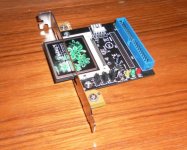NobodyIsHere
Veteran Member
- Joined
- Dec 20, 2006
- Messages
- 2,412
Hi! This is assess the level of interest in another round of SCSI to IDE/CF/SD prototype boards. I can get another batch and I've already had some requests. Please respond to the poll if you are interested. At least notionally, if I get 10 of the PCBs they would be $20 each to cover my costs.
This is a home brew community project so each builder constructs their own board. The SCSI to IDE/CF/SD project is currently underway with at least a couple builders with partially constructed units. No fully operational systems yet though as of 12 Jul 2011 AFAIK. As progress continues software and images will be posted to the N8VEM wiki.
Development of the software continues in an informal private email group with occasional updates to the N8VEM mailing list. All the design information is stored here on the N8VEM wiki
http://n8vem-sbc.pbworks.com/w/browse#view=ViewFolder¶m=MINI SCSI to IDE prototypes
Thanks and have a nice day!
Andrew Lynch
This is a home brew community project so each builder constructs their own board. The SCSI to IDE/CF/SD project is currently underway with at least a couple builders with partially constructed units. No fully operational systems yet though as of 12 Jul 2011 AFAIK. As progress continues software and images will be posted to the N8VEM wiki.
Development of the software continues in an informal private email group with occasional updates to the N8VEM mailing list. All the design information is stored here on the N8VEM wiki
http://n8vem-sbc.pbworks.com/w/browse#view=ViewFolder¶m=MINI SCSI to IDE prototypes
Thanks and have a nice day!
Andrew Lynch
Last edited:

